Thrive
Research project recovers, remembers lost history of Black cemeteries
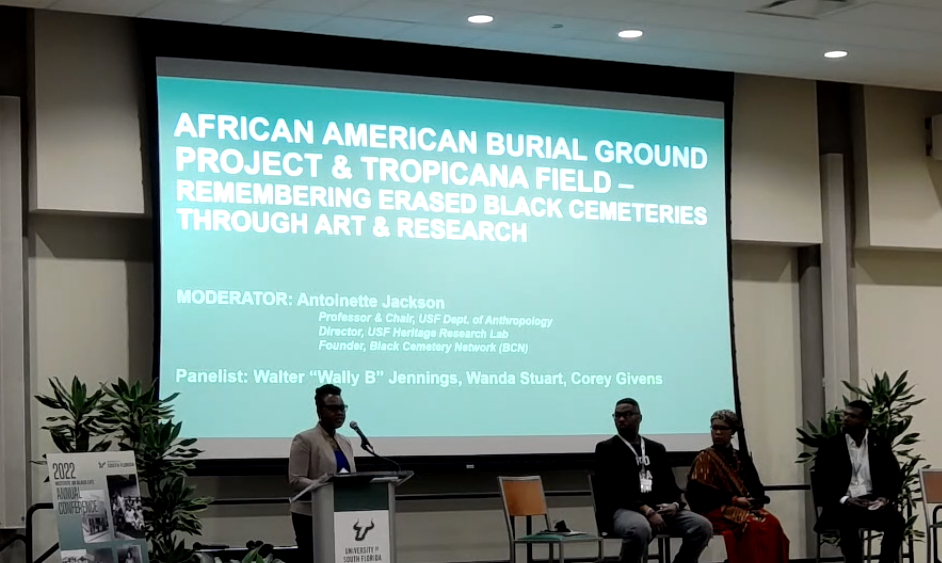
From Tampa to Clearwater to St. Petersburg, hundreds of unmarked graves are turning up at the former locations of historic African American cemeteries. After decades of neglect, abandonment and new construction, a project funded by the University of South Florida anti-racism initiative hopes to recover and remember the history of those hallowed grounds through research and art.
The African American Burial Grounds & Remembering Project is working with the community to identify and preserve those forgotten cemeteries throughout Tampa Bay. Antoinette Jackson, professor and chair of the USF Department of Anthropology, leads the project with help from university faculty, graduate students and several community partners. The team interviews people with strong connections to cemeteries through churches, funeral homes and family connections. They record oral histories and examine church records and historical archives in the hopes of identifying the buried – and bringing a dark history of neglect to light.
“Black cemeteries are Black history,” said Jackson as she opened her presentation at Tuesday’s Institute on Black Life (IBL) Annual Conference. “So, this is most fitting that we’re opening up the second half here talking about the historic African American cemetery erasure that is going on in the Tampa Bay area and the country.”
Jackson moderated a discussion titled “African American Burial Ground Project and Tropicana Field – Remembering Erased Black Cemeteries through Art and Research” at Tuesday’s conference, held at USF St. Petersburg. Joining Jackson on stage was Walter “Wally B” Jennings, spoken word artist and assistant director of diversity initiatives at USF; Wanda Stuart, resident of the former Gas Plant District; and Corey Givens, minister and community activist.
The research project began in 2020 following social unrest and the subsequent call for action by USF to focus on anti-racism and develop a better understanding of Black communities. The year before, ground-penetrating radar found hundreds of abandoned graves from Zion Cemetery buried beneath the Robles Park housing development in Tampa.
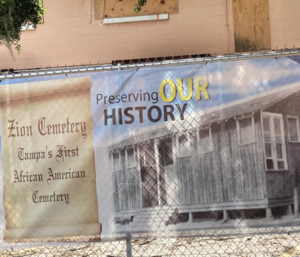
Zion Cemetery was one of the first African American cemeteries in Tampa Bay. Radar found over 300 graves on the grounds of what is now Robles Park Village in Tampa. Photo courtesy of heritagelab.org.
“So, that caught my attention as I’m sure it caught a lot of people’s attention,” said Jackson. “That was the impetus of one of the things that I thought we as a team would focus on.”
Jackson said as a cultural anthropologist, she is concerned with the impacts and implications that finding these graves has on the surviving community. She also hopes to find the proper path forward and uncover buried history.
“When I say razed cemeteries, I mean literally cemeteries that are sitting under new parking lots, housing complexes, highways – this is a very serious concern,” added Jackson.
The project, which includes researchers from the Tampa and St. Petersburg campuses and spans the entire Tampa Bay region, currently focuses on two historical Black cemeteries. The first is the aforementioned Zion Cemetery, one of the first African American cemeteries in Tampa Bay. The other is St. Petersburg’s Oaklawn Cemetery, which consists of three burial grounds now buried beneath Tropicana Field’s parking lots.
The three cemeteries in the area were built in the late 1800s as the final resting place for Civil War veterans and citizens of all races, although segregated. Jackson said the city condemned the complex in 1926, and residents expected the city would properly relocate the remains. In 1949, the construction of the Royal Court Apartments uncovered the first bodies.
In 1966, Royal Court became the Laurel Park housing complex, uncovering more remains and artifacts. In 1990, Laurel Park made way for Tropicana Field, and over 30 years later, widespread suspicions that the site still contained human remains proved true.
Ground-penetrating radar confirmed that bodies were still under the stadium’s asphalt last August, and many await further studies and the next steps. In the meantime, the research group seeks answers on how best to recognize the loss of history and memorialize those left without a proper burial place or markers.
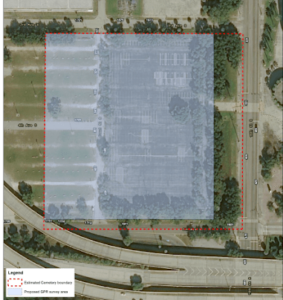
In August 2020, the Cardno company confirmed at least three burial sites underneath Tropicana Field parking lots 1 and 2. Photo: City of St. Petersburg.
“So, you can see throughout the history of that site, things were being developed overtop of the cemetery continuously,” said Jackson. “We, as part of this project team, are wanting to do the type of research necessary to understand what happened and how we can intervene and perhaps be a voice, and work with the community to be a voice, in these conversations about stopping this erasure moving forward.”
Jackson explained that a big part of creating that voice is through the help of local artists, like those on her panel. Jennings called the discovery of the graves a watershed moment and felt the responsibility to spread the word through the deep-rooted tradition of African griot. (The griot was responsible for passing down the oral history of tribes from generation to generation.)
As a spoken word artist, Jennings said he envisions himself in the same light and expressed the need to put faces and experiences alongside the data. Jennings also seeks to uncover any connections between the forgotten cemeteries and living conditions in those areas.
“How does the current condition of the Robles Park housing project, how is that related to the presence of Zion cemetery,” wondered Jennings. “In children and residents living amongst the unknown dead?”
For Givens, the project is personal. As a child, his grandmother Dorothy Beachum Givens would share memories of her grandfather, Will Williams, who helped pave St. Petersburg’s first streets and build its first seawall. When the city began exhuming bodies for relocation, it never notified his family if or where it moved his remains.
Givens said his family not knowing to this day what became of Williams after his burial piqued his interest in the project.
“Like Ms. Wanda (Stuart) said, ‘you don’t know who you are until you know where you came from,’” Givens reiterated. “So, I wanted to honor my family’s history by finding out where his final resting place was.”
Givens said he was jaded and disgruntled going into the project. Three separate times the cemetery was built over in the name of development. Three times the city decided “out of sight, out of mind,” Givens said.
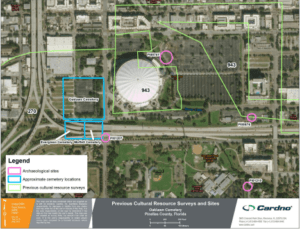
Previously conducted cultural resource surveys and archaeological sites in the vicinity of the former Oaklawn Cemetery. Photo: City of St. Petersburg.
Givens explained that many of these Black residents were out of sight due to a lack of headstones. Some were damaged and lost over time, while some families could not afford the markers. He said that places the focus on using nonarchival documents like obituaries and family Bibles to piece together history. He added it also requires working with institutions like USF, and Black newspapers like The Weekly Challenger, to tell those stories.
“Because if we don’t tell our stories – someone else will,” said Givens. “And they might not tell the truth.
“So, I want the truth to be told that Will Williams lived … and he left a rich legacy. And his story – along with all the other folks that were buried in those three cemeteries – they deserve to be told.”


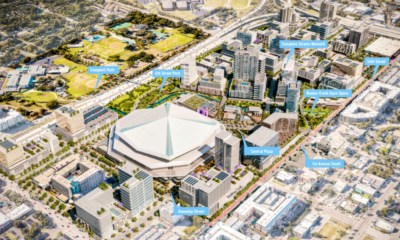





Danny White
February 3, 2022at2:12 pm
Wow, Ms Hayes! Your recollections are crucial to this noble endeavor. I hope the author shares your comments with the project leads.
rose hayes
February 3, 2022at12:27 pm
Bodies were moved from the Royal court site in order to build the apartments. Some of them were placed across 5th Avenue South in St. Petersburg, Fl, between 16th and 17th Streets South.. I participated in field trips there in 4th grade. My teacher was Thelma Cato at 16th Street Elementary School. We went into the cemetery to collect insects and butterflies for science. When the Interstate went through, I have no idea what they did with the bodies. Some may still be under the Interstate.